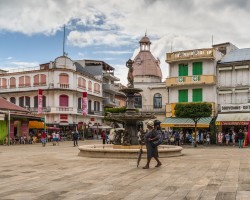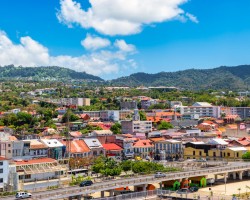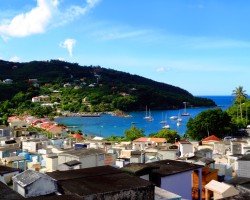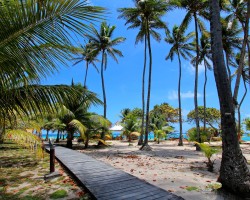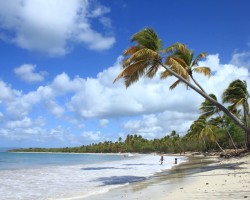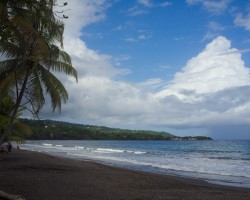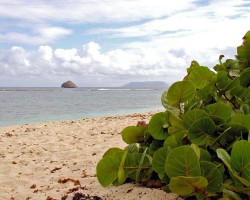Best time to go to Guadeloupe for a perfect weather and where to go?
When is the best time to go to Guadeloupe?
The best time to visit Guadeloupe is between December and April, during the dry season. Indeed, this is the ideal time to enjoy a relaxing stay and make the most of the island's beaches. You can expect temperatures ranging between 26 and 31 °C and many sunny days. If you travel in December, you can experience how the locals celebrate Christmas. However, as this period offers ideal weather conditions, there is a significant tourist influx, which may increase your travel budget.
Therefore, if you wish to avoid crowds, it is better to visit Guadeloupe during the low season, from June to November. While there may be rainfall, you will have the opportunity to experience the daily life of the locals in all its authenticity. Additionally, prices are generally more attractive. This period is also marked by local events, such as the celebration of the "cuisinières" in August.
Moreover, as rainfall usually occurs in the form of showers in the late afternoon, the rainy season remains pleasant for a trip. You will encounter mostly sunny moments, allowing you to enjoy the beaches and hikes on the island.
However, caution is advised if you travel during the hurricane season, as Guadeloupe is regularly affected by tropical depressions and hurricanes. Although the risk is higher between August and October, these episodes can occur randomly from June to November.
In conclusion, if you were wondering when to visit Guadeloupe, it appears that each season has its advantages and disadvantages.
Annual weather in Guadeloupe
For information about the climate and the weather city by city in Guadeloupe for a specific month, click on the corresponding line below:
| Month | Our opinion | View Details | |||
|---|---|---|---|---|---|
| January | 79°F to 81°F | good weather | |||
| February | 81°F | good weather | |||
| March | 79°F to 81°F | perfect weather | |||
| April | 81°F | good weather | |||
| May | 83°F | good weather | |||
| June | 85°F | good weather | |||
| July | 83°F to 85°F | tolerable weather | |||
| August | 85°F | tolerable weather | |||
| September | 85°F | tolerable weather | |||
| October | 85°F | tolerable weather | |||
| November | 85°F | tolerable weather | |||
| December | 83°F | good weather |
Best time to travel to Guadeloupe by cities
Climate and Weather in Guadeloupe
Guadeloupe, the largest island in the French West Indies, close to Saint-Martin and Saint-Barthélemy, experiences a tropical climate. It enjoys nearly 3,000 hours of sunshine per year, which is about eight hours a day. Moreover, the island experiences constant heat, although in the highlands, such as around the Soufrière volcano, the weather can sometimes cool down. It's true, Guadeloupe's climate is a dream! On-site, there are two main seasons:
- First, the dry season, also known as "le Carême", runs from December to April.
- Secondly, the rainy season or "Hivernage" takes place from June to November.

The dry season
This period is the most pleasant in terms of weather in Guadeloupe. Indeed, during the dry season, the presence of the northeast trade winds makes the heat more moderate. These winds typical of tropical zones blow regularly along the coasts. As a result, there are high but bearable temperatures and a long period of good weather.
Although some thunderstorms are possible, they usually pass quickly.
Many travelers choose to visit Guadeloupe in December. However, depending on the year, rainy days can still be frequent during this period. Therefore, to make the most of this time, it is best to travel between February and March, which are the driest months.
The rainy season
During the rainy season in Guadeloupe, temperatures are higher and there is high humidity. It often rains in the afternoon and the air is rarely cool. Indeed, during this period, the trade winds are less frequent. This gives the feeling of a heavier atmosphere, sometimes hard to bear. However, the temperature rarely exceeds 31°C.
Generally, precipitation comes in the form of thunderstorms or showers that often last less than an hour. The sun quickly returns under the Guadeloupean sky.
With a sea temperature equal to or above 26°C, swimming is possible all year round in Guadeloupe. However, it is even more enjoyable during the hot and humid season when it sometimes reaches 29°C.
However, this is also the period of hurricanes which can bring strong winds and torrential rains. Guadeloupe is regularly affected by these events and preventive measures are taken as early as June to ensure the safety of travelers and tourists.
Generally, the rainiest months are August and September. Therefore, the rainy season can be enjoyable between May and July, when precipitation is less significant and temperatures are lower.
Read more:
- What to do in Guadeloupe when it rains: our activity ideas to stay dry!
Climate of Guadeloupe according to regions
Guadeloupe is composed of a central island formed by two islands connected to each other: Basse-Terre in the west and Grande-Terre in the east. There are also other small islands: Marie-Galante, La Désirade, Les Saintes.
It is important to know that the climate in Guadeloupe is subject to microclimates. Thus, it is possible to have very good weather in one region while the rest of Guadeloupe experiences heavy rains.
Climate in Basse-Terre
First of all, it is often mentioned that the island of Basse-Terre is more humid than Grande-Terre. This is especially true near the La Soufrière volcano where clouds are usually present (but make visits to Basse-Terre fascinating!). The climate is rainy all year round in this area where a large tropical forest is found. Furthermore, temperatures drop as one approaches the volcano's summit. The presence of a constant cool wind will require travelers to bring warm clothing when heading to the highlands.
Climate in Grande-Terre
Moreover, if the climate is slightly less humid in Grande-Terre, there are differences depending on the areas of the island.
Indeed, the coasts located in the west, such as Pointe-à-Pitre, receive more rainfall than the eastern coasts, such as Saint-François. Furthermore, the weather is often sunnier in the north of Grande-Terre.
Climate on the small islands of Guadeloupe
On the other hand, the small islands of Guadeloupe have fewer reliefs and therefore experience less precipitation than Basse-Terre and Grande-Terre.
The climate is similar on La Désirade or Marie-Galante, but Les Saintes benefit from a less humid weather. Furthermore, the wind blows regularly in this area even during the humid season, providing a cooler and more pleasant feeling.
Temperatures and rainfall in Guadeloupe
On these 3 graphs, we present the evolution of temperatures of Guadeloupe and month-by-month rainfall for the cities of Pointe-à-Pitre, Basse-terre, Deshaies, Les Saintes and Marie-Galante, as well as the month-by-month sea temperature for coastal cities.
Peak visitor numbers and tourist seasons in Guadeloupe
Find out when Guadeloupe has its high tourist season (the period when the influx of tourists is highest) and off-peak tourist season using our data and figures.
Tourist seasons in Guadeloupe
The months with low numbers of tourists are: May, June, July, September, October and November. The number of visitors to Guadeloupe is high in: January, February, March, April, August and December.
- Very low season in Guadeloupe: June and September.
- Low season in Guadeloupe: May, July, October and November.
- High season in Guadeloupe: January, March, April and August.
- Peak season in Guadeloupe: February and December.
Figure: Visitor index for Guadeloupe month by month
Average price for flights to Guadeloupe
A return flight between Montreal and Pointe-à-Pitre is generally cheaper if you go in april ($ 780 on average): this is the best time for travellers on a tight budget. In contrast, you may end up paying $ 380 more for your airline ticket to Pointe-à-Pitre if you go in july.
Find the best price for your flight Flight prices to Guadeloupe
Where to go in Guadeloupe?
This table allows you to see the maximum temperature for each city and our opinion on the weather month by month (see colour legend below the table).
| Cities | jan. | feb. | mar. | apr. | may | jun. | jul. | aug. | sep. | oct. | nov. | dec. |
| Pointe-à-Pitre | 81°F | 81°F | 81°F | 81°F | 83°F | 85°F | 85°F | 85°F | 86°F | 85°F | 85°F | 83°F |
| Basse-terre | 81°F | 81°F | 81°F | 81°F | 83°F | 85°F | 85°F | 85°F | 86°F | 85°F | 85°F | 83°F |
| Deshaies | 81°F | 81°F | 81°F | 81°F | 83°F | 85°F | 85°F | 85°F | 86°F | 85°F | 85°F | 83°F |
| Les Saintes | 81°F | 81°F | 81°F | 83°F | 83°F | 85°F | 85°F | 85°F | 86°F | 85°F | 85°F | 83°F |
| Marie-Galante | 81°F | 81°F | 81°F | 81°F | 83°F | 85°F | 85°F | 85°F | 85°F | 85°F | 85°F | 83°F |
| Sainte-Anne | 81°F | 81°F | 81°F | 81°F | 83°F | 85°F | 85°F | 85°F | 86°F | 85°F | 85°F | 83°F |
| Trois-Rivières | 81°F | 81°F | 81°F | 81°F | 83°F | 85°F | 85°F | 85°F | 86°F | 85°F | 85°F | 83°F |
| Goyave | 81°F | 81°F | 81°F | 81°F | 83°F | 85°F | 85°F | 85°F | 86°F | 85°F | 85°F | 83°F |
| Baie-Mahault | 81°F | 81°F | 81°F | 81°F | 83°F | 85°F | 85°F | 85°F | 86°F | 85°F | 85°F | 83°F |
| Capesterre-Belle-Eau | 81°F | 81°F | 81°F | 81°F | 83°F | 85°F | 85°F | 85°F | 86°F | 85°F | 85°F | 83°F |
| Gros Cap | 81°F | 81°F | 81°F | 81°F | 83°F | 85°F | 85°F | 85°F | 86°F | 85°F | 85°F | 83°F |
| island of Désirade | 81°F | 81°F | 81°F | 81°F | 83°F | 85°F | 85°F | 85°F | 86°F | 85°F | 85°F | 83°F |
| La pointe des châteaux | 81°F | 81°F | 81°F | 81°F | 83°F | 85°F | 85°F | 85°F | 86°F | 85°F | 85°F | 83°F |
| La Soufrière | 81°F | 81°F | 81°F | 81°F | 83°F | 85°F | 85°F | 85°F | 86°F | 85°F | 85°F | 83°F |
| Lamentin | 81°F | 81°F | 81°F | 81°F | 83°F | 85°F | 85°F | 85°F | 86°F | 85°F | 85°F | 83°F |
| Les Abymes | 81°F | 81°F | 81°F | 81°F | 83°F | 85°F | 85°F | 85°F | 86°F | 85°F | 85°F | 83°F |
| Morne-à-l'Eau | 81°F | 81°F | 81°F | 81°F | 83°F | 85°F | 85°F | 85°F | 86°F | 85°F | 85°F | 83°F |
| Parc national de Guadeloupe | 81°F | 81°F | 81°F | 81°F | 83°F | 85°F | 85°F | 85°F | 86°F | 85°F | 85°F | 83°F |
| Petite-Terre Islands | 81°F | 81°F | 81°F | 81°F | 83°F | 85°F | 85°F | 85°F | 86°F | 85°F | 85°F | 83°F |
| Pointe Allègre | 81°F | 81°F | 81°F | 81°F | 83°F | 85°F | 85°F | 85°F | 86°F | 85°F | 85°F | 83°F |
Legend:
perfect weather
good weather
tolerable weather
About Guadeloupe
What can I do in Guadeloupe?
Beaches / swimming
Nature and countryside
Culture and heritage
Sports
Family travel
Crafts / shopping
Gastronomy
Nightlife
Is this weather information for Guadeloupe reliable?
Climate data for Guadeloupe has been gathered every day since January 2009. The analysis of these meteorological data for Guadeloupe allows us to determine the average for each month in Pointe-à-Pitre, Basse-terre, Deshaies, Les Saintes, Marie-Galante, Sainte-Anne, Trois-Rivières, Goyave, and 24 other cities.
So yes: this data is reliable except in cases of temporary climate disruption in the region.

